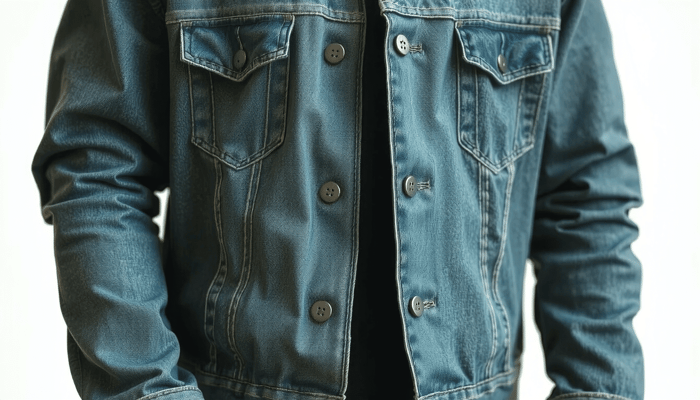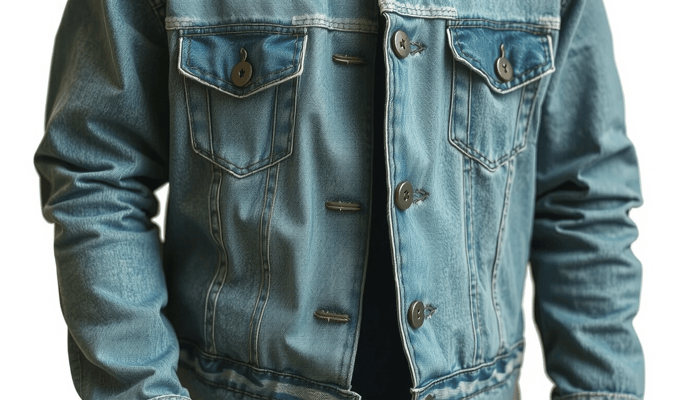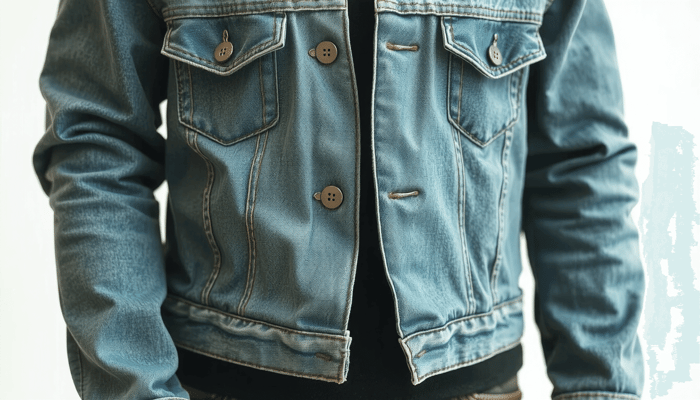How Should a Jean Jacket Fit? The Ultimate Guide to a Perfect Look
 Mr. Eton Yip | 32+ Year Garment Manufacturing Expert & Founder of Eton Garment
Garment Industry
Mr. Eton Yip | 32+ Year Garment Manufacturing Expert & Founder of Eton Garment
Garment Industry
July 20th, 2025
8 minute read
Table of Contents
A well-fitting jean jacket is more than clothing. It's a timeless wardrobe essential that brings effortless cool to any outfit. But finding the perfect fit can be tricky. Many people wonder exactly how should a jean jacket fit, especially with so many different styles to choose from.
This guide will clear up the confusion. We'll show you the key points for a classic fit and give you a simple "fit test" to use in any store. You'll also learn how the rules change for modern styles like oversized and cropped jackets. By the end, you'll know how to find your perfect denim companion.

The 5-Point Check: A Classic Fit
To understand how should a jean jacket fit, start with the classic "trucker" style. These five checkpoints create a sharp, timeless look. Master them and you'll know how to judge any denim jacket you try on.
1. The Shoulders: Foundation of Fit
The shoulder seams matter most. They should sit right on the edge of your shoulder bone, where your shoulder starts to curve into your arm.
Seams that droop down your bicep mean the jacket is too big. It will look sloppy. Seams that sit too close to your neck mean it's too small and will limit your movement. Good shoulder fit creates a clean, structured look.
2. The Chest & Torso: Snug but Not Suffocating
A classic jean jacket should feel snug across your chest and torso. Never tight or restrictive. You should button it up completely without the fabric pulling into an "X" shape across your chest.
The right fit gives you room for layering. A bulky hoodie won't fit under a classic cut, but expert style guides suggest you should have space for a t-shirt or light sweater. This makes your jacket work across seasons.
3. The Sleeve Length: The "Just Right" Rule
Sleeves should end right at your wrist bone or just beyond it. This length looks intentional and well-proportioned.
Long sleeves bunch up and look wrong. Short sleeves make it seem like you've outgrown the jacket. Cuffing sleeves is a great style choice, but it shouldn't be needed to fix poor fit.
4. The Body Length: Hitting the Sweet Spot
A traditional jean jacket should hit at or just below your waistband, around your hip bone. This is key to how should a jean jacket fit for a balanced look.
This classic length works with everything. Jeans, chinos, and dresses all look good with it. It defines your waistline without cutting your torso in half, creating a flattering shape for most body types.

5. The Armholes: Ensuring Free Movement
People often ignore the armholes, but they're huge for comfort. They should be cut high enough to let you move freely without making the whole jacket lift when you raise your arms.
Low armholes make the jacket feel baggy and awkward. High, tight ones make you feel trapped. The right fit lets you move freely and comfortably all day.
The In-Store Fit Test: 4 Moves to Guarantee Perfection
Looking in the mirror helps, but feeling the fit matters more. Here's our secret weapon for the fitting room. These moves test how a jean jacket really fits during everyday activities.
Step 1: The Hug Test
Cross your arms in front of your body like you're hugging yourself. This tests the fit across your back and shoulders.
If the fabric pulls hard or feels like it might tear, the jacket is too small. You should feel slight tension, but it shouldn't stop the movement.
Step 2: The Reach Test
Reach both arms straight out, then raise them overhead. Watch two things: the sleeves and the hem.
Sleeves shouldn't ride up too much, showing your whole forearm. The jacket body shouldn't lift more than a couple inches from your waist. This confirms the armholes work well and the proportions fit your body.
Step 3: The Button-Up & Sit-Down
Button the jacket completely and sit down. This is the ultimate test for fit around your torso and hips.
Does the jacket pull or dig into your stomach or hips? A good jacket stays comfortable when you're seated. If it strains at the buttons, it's too tight for real wear.
Step 4: The Layering Check
If you plan to wear more than a t-shirt under your jacket, try it with the thickest item you'd normally layer underneath, like a knit sweater.
This final check confirms the size works for your whole wardrobe. If you can still do the other tests comfortably with a layer on, you've found a winner. This is the best way to figure out how should a jean jacket fit for year-round wear.
Beyond the Classic: How Different Styles Should Fit

Not all jean jackets follow the same rules. Modern styles like oversized and cropped have their own fit requirements. Understanding these differences helps you pick the right jacket for your style. Your choice might depend on what will best complement your body shape and height.
| Style | Shoulder Fit | Body Fit & Sleeves | Length | Best For |
|---|---|---|---|---|
| Classic/Trucker | Seams on shoulder bone | Snug with room for a light layer; sleeves hit the wrist. | Hits at or just below the hip bone. | A timeless, versatile look. |
| Oversized/Boyfriend | Seams intentionally drop off the shoulder. | Roomy and boxy through the body; sleeves may be long and need cuffing. | Extends past the hips, often mid-thigh. | Casual, layered, and streetwear styles. |
| Cropped | Seams on shoulder bone or slightly in. | Can be fitted or boxy, but the main feature is the length. | Hits at the natural waist or above. | Highlighting the waist; pairs well with high-waisted bottoms or dresses. |
Common Fit Problems and How to Solve Them
Sometimes store-bought jackets aren't quite perfect. Here are fixes for the most common fit issues.

Problem: The jacket fits in the shoulders but is too tight/loose in the body.
This happens a lot, especially for athletic builds. Look for brands with different cuts like "slim fit," "regular fit," or "relaxed fit" to match your body shape better.
Problem: The sleeves are too long.
This is easy to fix. A simple, crisp cuff is a built-in style move that looks great on any jean jacket. For a permanent fix, a tailor can shorten denim sleeves easily and cheaply.
Problem: It's just not quite right.
Don't hesitate to use a good tailor. They're experts at perfecting fit. A tailor can take in the sides for a more tapered shape or add darts to remove back bagginess. This transforms a good fit into a great one. For brands wanting perfect fit from the start, working with an experienced manufacturer like Etongarment ensures every design is made with precise, consistent fit specs.
Frequently Asked Questions (FAQ)
Quick answers to common questions about how should a jean jacket fit.
1. Should you size up or down in a jean jacket?
It depends on how you'll wear it. For a traditional look over t-shirts and thin tops, stick to your true size. If you want to layer over chunky sweaters and hoodies, size up. Always use the "Fit Test" to be sure.
2. Is a jean jacket supposed to be tight?
A classic jean jacket should be snug, not tight. It should show your shape without limiting movement. Oversized styles are different - they're meant to be loose and roomy for a relaxed look.
3. How do you know if a jean jacket is too big?
Clear signs include shoulder seams falling far down your arms, lots of bunched fabric in the back and chest, and sleeves that swallow your hands. Good fit should feel structured, not overwhelming.
4. Can you wear a jean jacket with jeans?
Absolutely! The "Canadian tuxedo" is classic. The trick is contrast. Pair a light-wash jacket with dark jeans, or a black jacket with blue jeans. This creates visual separation and keeps the outfit modern.
5. Does 100% cotton denim stretch?
Yes, 100% cotton denim gives and molds to your body over time, especially at the elbows and shoulders. But it won't have the elastic "snap-back" of denim mixed with elastane. It's often best to buy 100% cotton jackets slightly snug, knowing they'll relax with wear. Denim quality, often determined by manufacturing, affects how it wears over time. For insights into quality garment production, visit Etongarment.
Related Articles
Jacket vs. Coat: The Definitive Guide to Choosing the Right Outerwear
9 minute read
July 20th, 2025
Introduction: More Than Just a NameThe terms "jacket" and "coat" are frequently confused by... more »
How to Wear a Denim Jacket: Complete Style Guide for 2025
12 minute read
July 20th, 2025
The denim jacket is undoubtedly a classic. This piece of clothing has long represented the simplicity... more »
Restoring a Stinky Leather Jacket: All You Need To Know To Remove Any Odor From a Leather Jacket
10 minute read
July 20th, 2025
You pull your favorite leather jacket from the closet, excited to wear it. But then an undesirable... more »
From Fabric to Finished: Your Ultimate Guide on How to Sew a Jacket
10 minute read
July 20th, 2025
Making a first-time jacket is a big milestone in sewing. It is the thing that differentiates the casual... more »
How to Clean a Leather Jacket at Home: The Complete Step-by-Step Guide
11 minute read
July 19th, 2025
A quality leather jacket is more than just wearing it. It is a long-term investment, and it serves as... more »

